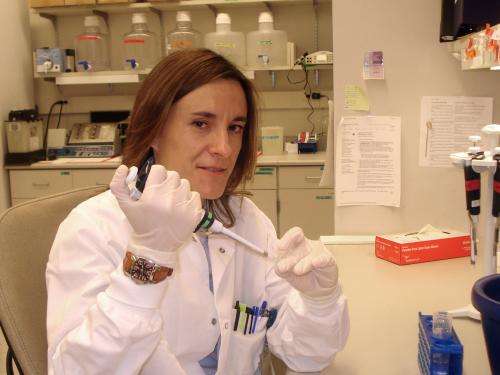Pancreatic cancer diagnosis under review

A team of researchers of the UPV/EHU together with researchers from the Hospital Clínico of Barcelona have produced a bibliographical review that summarises the data currently existing on the markers for pancreatic cancer, and have published it in the specialised journal Clinica Chimica Acta.
The study was led by Marta Herreros-Villanueva through a programme that Luis Bujanda is involved in; both of them are members of staff of the Networked Centre for Biomedical Research into Hepatic and Digestive Diseases (CIBERehd) at the Hospital Donostia, and of the UPV/EHU's Biodonostia Institute. It is an important piece of work that arranges all the existing information on the markers for this disease.
Various cancer types may develop in the pancreas, but what is commonly known as pancreatic cancer is ductal adenocarcinoma of the pancreas, which is the most common. "90-95% of pancreatic cancers are adenocarcinomas," says Marta Herreros, main author of the work.
Ductal cells in the pancreas form ducts or tubes that transport what is produced by other pancreatic cell types, the acinar cells. In ductal adenocarcinoma, the cells form many more ducts than normal. This leads to the formation of tumours.
Adenocarcinoma is not among the most frequent cancer types, but it is among those with the highest mortality rate. And the reason for this is clear for the researchers. "The fact that sets pancreatic cancer apart from other tumour types is that by the time it has been detected, it is very late," explains Herreros. "It isn't because the cells of a pancreatic tumour grow more quickly than those of other kinds of tumours but that the techniques we have for spotting it do not allow us to do so at an early stage." The disease is reckoned to take several years to develop, perhaps between five and ten years, but it does not tend to be diagnosed until the final phase.
Complicated diagnosis
There are in fact two big difficulties hampering the diagnosis: the difficulty in accessing the pancreas and the lack of good markers for the disease.
Firstly, the pancreas is an internal organ which makes it difficult to get at. "With an endoscopy, for example, you can easily access a tumour of the colon; or with a breast tumour you can also access it easily with a mammography and see it. But accessing the pancreas is complicated. That is why by the time it is diagnosed it is usually late; there is no technique for accessing the pancreas directly and seeing what is there," says Herreros.
Secondly, there is no specific, reliable marker that in fact indicates the presence of an adenocarcinoma. Currently, the diagnosis is made thanks to the CA19-9 marker, a glycoprotein present in the bloodstream of many patients with pancreatic cancer. This marker is a standard one worldwide: it is the molecule that doctors are looking for in blood tests designed to detect pancreatic cancer.
"The CA19-9 is the marker established worldwide. Then, on an experimental level there are some of the molecules we have included in our publication, but they are just clinical trials; the patients are not routinely evaluated using these other molecules," says Herreros.
Furthermore, the CA19-9 is not a very good marker, because it is neither specific nor sensitive. "It isn't very useful in pancreatic cancer because there are patients who, despite having the disease, do not have a very high presence of it, they just have it within very normal ranges, and then there are patients with a high level of this protein who do not have pancreatic cancer. They may have pancreatitis or other kinds of tumours," explains Herreros.
This means that the prognosis is imprecise and the diagnosis through the analysis of the CA19-9 marker comes too late in many cases.
That is why it is crucial to seek other markers to make a diagnosis . "That's what we're working on," says Herreros. "But it's very complicated and there aren't many samples or many patients to analyse, because of the high mortality rate of the cancer and because many patients do not undergo operations, and therefore, we cannot obtain many samples of the cancerous tissue. What is more, until now there hasn't been much money available either to study this disease."
More information: www.sciencedirect.com/science/ … ii/S0009898113000053














